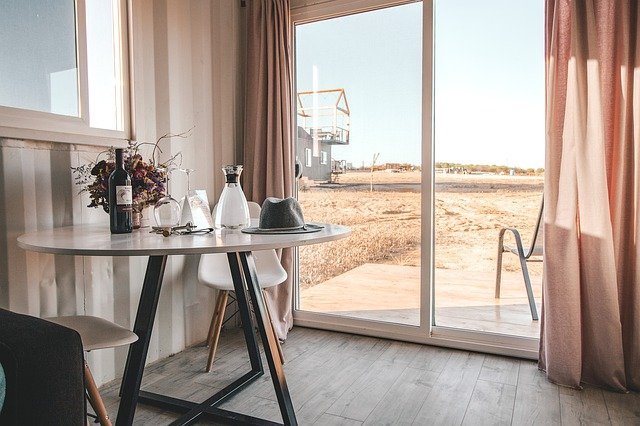
Glass is a synthetic solid material that is typically transparent or translucent and hard, brittle, and resistant to the elements.
Glass has been used in making useful and beautiful products since ancient times, and it remains important in several industries such as building construction, housewares, and telecommunications.
It’s made by cooling molten components like silica sand fast enough so that the molecules don’t have time to form crystals.
How is glass invented?
The history of glass
Glass, a product of human ingenuity and creativity, has been around for more than 5,000 years.
Archaeological evidence indicates that the earliest glass objects were beads and decorative objects found in Egypt dating back to 3000 BC.
The potters of Mesopotamia were making objects from glass by 2500 BC.
The first glass making process was probably invented in Syria or Palestine.
The process was based on the ancient technique of fusing (melting) together different colored glasses to produce a new color.
This process was called “murrine” and it was used in all early glass making areas.
Arabian traders brought knowledge of glass making to Europe in the 12th century.
Europeans refined the process by adding lead oxide, which produced a superior product with greater brilliance and clarity than that made in the Middle East.
The Venetians learned how to control the temperature of the molten mixture, which helped them to produce a superior glass.
Soon glassware became popular throughout Europe and in countries where Europeans settled, such as America.
In 1597 an Englishman named George Ravenscroft was manufacturing glass in London when he learned about a new technique being used by the Venetians.
It was a technique by which glass could be blown from a globular “bubble” of molten glass, rather than having it poured into a mold or pressed into shape.
How glass is made in nature?
In nature, glasses are created when sand and/or rocks, which typically include a lot of silica, are heated to high temperatures and then rapidly cooled.
The Glass in Nature display features examples of glass manufactured in nature. For example, obsidian or volcanic glass is molten rock that has quickly cooled into a glassy state.
The desert glass found in the western United States is thought to be the result of a meteorite impact that occurred about 13,000 years ago.
The oldest known natural glass is a piece of black glass that was recovered from a Libyan desert site and dates back to about 4.4 billion years ago.
The most common type of natural glass is obsidian, which is made of the same ingredients as man-made glass (although in many different proportions) and is therefore called natural glass.
Natural glasses can also be found on other planets, such as Mars.
The modern glass

The modern glassmaking process was developed in the early 19th century.
Prior to that, glass was made by heating a mixture of ingredients including sand, lime, and soda in a furnace until the material became liquid.
The liquid was then poured into a mold and allowed to cool and harden.
Glass making techniques were improved in the early 1800s by Englishman Michael Faraday, an experimentalist who was also very proficient at developing theories to explain his findings.
He experimented with chemicals until he found a mixture of silica sand, soda, and lime that would melt when heated in a furnace.
When cooled rapidly, it formed a smooth solid material with no crystals.
This new product—called a glass melt—was suitable for use in creating tableware and other goods.
Modern glass invention
Michael Faraday made the first known attempt at the scientific analysis of glass in 1825, but he did not succeed in identifying its composition.
In 1845, German-born Carl Joseph Bayer and his partner Charles British invented the machine that could produce sheet glass.
The first practical method for manufacturing plate and sheet glass from a molten mass was also developed in the mid-19th century.
The use of float glass, which is made by floating a ribbon of hot glass on a bed of molten tin, was pioneered in the early 20th century.
Float glass is free from defects and has a very even thickness, which makes it ideal for use in windows, mirrors, and other products.
The manufacture of fiberglass was developed during World War II to meet the need for lightweight, durable materials that could be used in aircraft and other military equipment.
Fiberglass is made by melting silica sand with other ingredients and then spinning the resulting liquid into fibers.
These are collected on a moving screen, where the fibers bond together to form a light, rigid rods called filament tape.
The tape is then wound into a large spool, which can be cut to form the finished product.
What is used to make glass?
The ingredients used to make glass are:
- Sand (silica) — The main component of glass
- Soda (sodium carbonate) — A flux that helps to lower the melting point of the sand
- Lime (calcium oxide)— Helps to produce a strong, durable glass product
- Potassium nitrate — A colorant and a flux and also used to make saltpeter for gunpowder
- Dolomite (calcium magnesium carbonate)— Helps to strengthen the finished product
- Copper — Used as a stabilizer to help keep the molten mixture from re-crystallizing
Some glass is made of sand (silica, silicon dioxide) and lime (calcium oxide), an alkali that aids in the melting of the sand.
Even though most sand contains some amount of feldspar, enough lime is added to make the glass alkaline.
Soda (sodium carbonate) or potash (potassium carbonate) may also be used to lower the melting point and produce a stronger, more durable product.
All of these ingredients are fused together in a furnace at temperatures up to 3000 degrees Fahrenheit until the mixture becomes liquid.
This molten glass is then poured into a mold and allowed to cool and harden.
- See also: How was the invention of the microwave
- See also: The history of money and its evolution
How glass is made step by step?
Glass is actually created from liquid sand.
You can create glass by heating regular sand (which is mostly composed of silicon dioxide) till it melts and transforms into a fluid.
That won’t happen on your local beach: sand melts at a temperature of 1700°C (3090°F), which is well above the melting point of common rock. In fact, you could make glass from a common rock if you can get it hot enough.
But when sand is heated to high temperatures, the silicon dioxide in the sand breaks down and forms a liquid with other components in the sand.
Quartz melts at a slightly lower temperature than pure silicon dioxide because there’s a tiny amount of impurities in quartz that interfere with the crystalline structure.
Adding materials like sodium carbonate (soda) or potassium carbonate (potash) to the melt can lower the temperature necessary to form glass, and these additives may also improve the strength and durability of the finished product.
Another material that is sometimes added to glass is lime, which helps to produce a strong product.
When the mixture of ingredients is heated to a temperature of around 3000°F, it becomes a liquid and can be poured into a mold to cool and harden.
The finished product will be less dense than the original sand mixture and may contain air bubbles that were trapped in the glass while it was being formed.
The physical properties of glass, such as its brittleness and lack of tensile strength compared to more traditional materials like steel or wood, means that glass has typically only been used for applications where it doesn’t need to perform under stress (such as drinking glasses) or where it’s not exposed to mechanical forces.
Conclusion
Glass is a fascinating material that has been used for centuries in a variety of applications.
Although it has some limitations compared to other materials, glass has many unique properties that make it an excellent choice for certain situations.
In particular, its transparency and ability to refract light make it a popular choice for windows and other types of glazing.
Glass is also extremely versatile and can be produced in a variety of shapes, sizes, colors, and levels of durability depending on the needs of the application.



